Male Fertility Genes in Bread Wheat (Triticum aestivum L.) and Their Utilization for Hybrid Seed Production
Abstract
1. Introduction
2. Sporophytic Genes Involved in Anther and Pollen Development in Wheat
2.1. Male Sterile Mutants in Wheat Identified through Forward Genetics
2.2. Male Sterile Mutants in Wheat Revealed through Reverse Genetics
2.3. Analysis of Male Fertility Genes Ms1, Ms5, TaMs26 and TaMs45
2.4. Ms1, Ms5, TaMs26 and TaMs45 Exhibit Different Levels of Functional Redundancy
2.5. Temperature and Photoperiod Influenced Male Fertility
3. Hybridization Systems for Hybrid Seed Production in Wheat
3.1. CHA-Based Hybridization System
3.2. Genetic Hybridization Systems
3.2.1. CMS Hybridization System
3.2.2. Hybridization Systems Based on NGMS
TGMS- and PTGMS-Based Hybridization Systems
Hybridization Systems Based on Non-Conditional Recessive NGMS
Hybridization Systems Based on Dominant NGMS
4. Role of Gene Editing in Developing Next Generation Wheat Hybridization Systems
5. Conclusions
Author Contributions
Funding
Data Availability Statement
Acknowledgments
Conflicts of Interest
References
- Brenchley, R.; Spannagl, M.; Pfeifer, M.; Barker, G.L.A.; D’Amore, R.; Allen, A.M.; McKenzie, N.; Kramer, M.; Kerhornou, A.; Bolser, D.; et al. Analysis of the bread wheat genome using whole-genome shotgun sequencing. Nature 2012, 491, 705–710. [Google Scholar] [CrossRef] [PubMed]
- Whitford, R.; Fleury, D.; Reif, J.C.; Garcia, M.; Okada, T.; Korzun, V.; Langridge, P. Hybrid breeding in wheat: Technologies to improve hybrid wheat seed production. J. Exp. Bot. 2013, 64, 5411–5428. [Google Scholar] [CrossRef]
- Tilman, D.; Balzer, C.; Hill, J.; Befort, B.L. Global food demand and the sustainable intensification of agriculture. Proc. Natl. Acad. Sci. USA 2011, 108, 20260–20264. [Google Scholar] [CrossRef] [PubMed]
- Longin, C.F.H.; Mühleisen, J.; Maurer, H.P.; Zhang, H.; Gowda, M.; Reif, J.C. Hybrid breeding in autogamous cereals. Theor. Appl. Genet. 2012, 125, 1087–1096. [Google Scholar] [CrossRef] [PubMed]
- Mette, M.F.; Gils, M.; Longin, C.F.H.; Reif, J.C. Hybrid Breeding in Wheat. In Advances in Wheat Genetics: From Genome to Field, Proceedings of the 12th International Wheat Genetics Symposium, Yokohama, Japan, 8–14 September 2013; Ogihara, Y., Takumi, S., Handa, H., Eds.; Springer: Tokyo, Japan, 2015; pp. 225–232. [Google Scholar]
- Gowda, M.; Longin, C.F.H.; Lein, V.; Reif, J.C. Relevance of Specific versus General Combining Ability in Winter Wheat. Crop Sci. 2012, 52, 2494–2500. [Google Scholar] [CrossRef]
- Longin, C.F.H.; Gowda, M.; Mühleisen, J.; Ebmeyer, E.; Kazman, E.; Schachschneider, R.; Schacht, J.; Kirchhoff, M.; Zhao, Y.; Reif, J.C. Hybrid wheat: Quantitative genetic parameters and consequences for the design of breeding programs. Theor. Appl. Genet. 2013, 126, 2791–2801. [Google Scholar] [CrossRef] [PubMed]
- Muhleisen, J.; Maurer, H.P.; Stiewe, G.; Bury, P.; Reif, J.C. Hybrid Breeding in Barley. Crop Sci. 2013, 53, 819–824. [Google Scholar] [CrossRef]
- McRae, D.H. Advances in chemical hybridization. Plant Breed. Rev. 1985, 3, 169–191. [Google Scholar]
- Kempe, K.; Gils, M. Pollination control technologies for hybrid breeding. Mol. Breed. 2011, 27, 417–437. [Google Scholar] [CrossRef]
- Wilson, J.A.; Ross, W.M. Male Sterility Interaction of the Triticum Aestivum Nucleus and Triticum Timopheevi Cytoplasm; Kyoto University: Kyoto, Japan, 1962. [Google Scholar]
- Mukai, Y.; Tsunewaki, K. Basic studies on hybrid wheat breeding. Theor. Appl. Genet. 1979, 54, 153–160. [Google Scholar] [CrossRef] [PubMed]
- Adugna, A.; Nanda, G.S.; Singh, K.; Bains, N.S. A comparison of cytoplasmic and chemically-induced male sterility systems for hybrid seed production in wheat (Triticum aestivum L.). Euphytica 2004, 135, 297–304. [Google Scholar] [CrossRef]
- Sedlacek, T.; Horcicka, P. Proposal of updated XYZ system for the production of hybrid wheat seed. Czech J. Genet. Plant 2019, 55, 35–38. [Google Scholar] [CrossRef]
- Zhang, D.; Yang, L. Specification of tapetum and microsporocyte cells within the anther. Curr. Opin. Plant Biol. 2014, 17, 49–55. [Google Scholar] [CrossRef] [PubMed]
- Quilichini, T.D.; Grienenberger, E.; Douglas, C.J. The biosynthesis, composition and assembly of the outer pollen wall: A tough case to crack. Phytochemistry 2015, 113, 170–182. [Google Scholar] [CrossRef] [PubMed]
- Ariizumi, T.; Toriyama, K. Genetic Regulation of Sporopollenin Synthesis and Pollen Exine Development. Annu. Rev. Plant Biol. 2011, 62, 437–460. [Google Scholar] [CrossRef] [PubMed]
- Kaul, M.L.H. Genic male sterility. In Male Sterility in Higher Plants; Springer: Berlin, Germany, 1988; pp. 155–194. [Google Scholar]
- Ma, H. Molecular genetic analysis of microsporogenesis and microgametogenesis in flowering plants. Annu. Rev. Plant Biol. 2005, 56, 393–434. [Google Scholar] [CrossRef] [PubMed]
- Wilson, Z.A.; Zhang, D.-B. From Arabidopsis to rice: Pathways in pollen development. J. Exp. Botony 2009, 60, 1479–1492. [Google Scholar] [CrossRef] [PubMed]
- Shi, J.; Cui, M.; Yang, L.; Kim, Y.-J.; Zhang, D. Genetic and Biochemical Mechanisms of Pollen Wall Development. Trends Plant Sci. 2015, 20, 741–753. [Google Scholar] [CrossRef] [PubMed]
- Suneson, C.A. Use of Pugsley’s sterile wheat in cross breeding. Crop Sci. 1962, 2, 534–535. [Google Scholar] [CrossRef]
- Fossati, A.; Ingold, M. A male sterile mutant in Triticum aestivum. Wheat Inf. Serv. 1970, 30, 8–10. [Google Scholar]
- Driscoll, C.J. Induction and use of the ‘‘Cornerstone’’ male sterility in wheat. In Proceedings of the 5th International Wheat Genetics Symposium, New Delhi, India, 23–28 February 1978; pp. 499–502. [Google Scholar]
- Klindworth, D.L.; Williams, N.D.; Maan, S.S. Chromosomal location of genetic male sterility genes in four mutants of hexaploid wheat. Crop Sci. 2002, 42, 1447–1450. [Google Scholar] [CrossRef]
- Zhou, K.; Wang, S.; Feng, Y.; Ji, W.; Wang, G. A new male sterile mutant LZ in wheat (Triticum aestivum L.). Euphytica 2008, 159, 403–410. [Google Scholar] [CrossRef]
- Tucker, E.J.; Baumann, U.; Kouidri, A.; Suchecki, R.; Baes, M.; Garcia, M.; Okada, T.; Dong, C.; Wu, Y.; Sandhu, A.; et al. Molecular identification of the wheat male fertility gene Ms1 and its prospects for hybrid breeding. Nat. Commun. 2017, 8, 869. [Google Scholar] [CrossRef] [PubMed]
- Ni, F.; Qi, J.; Hao, Q.Q.; Lyu, B.; Luo, M.C.; Wang, Y.; Chen, F.J.; Wang, S.Y.; Zhang, C.Z.; Epstein, L.; et al. Wheat Ms2 encodes for an orphan protein that confers male sterility in grass species. Nat. Commun. 2017, 8, 1–12. [Google Scholar] [CrossRef] [PubMed]
- Guttieri, M.J. Ms3 dominant genetic male sterility for wheat improvement with molecular breeding. Crop Sci. 2020, 60, 1362–1372. [Google Scholar] [CrossRef]
- Maan, S.; Kianian, S. Third dominant male sterility gene in common wheat. Wheat Inf. Serv. 2001, 93, 27–31. [Google Scholar]
- Pallotta, M.A.; Warner, P.; Kouidri, A.; Tucker, E.J.; Baes, M.; Suchecki, R.; Watson-Haigh, N.; Okada, T.; Garcia, M.; Sandhu, A.; et al. Wheat ms5 male-sterility is induced by recessive homoeologous A and D genome non-specific lipid transfer proteins. Plant J. 2019, 99, 673–685. [Google Scholar] [CrossRef]
- Singh, M.; Kumar, M.; Thilges, K.; Cho, M.-J.; Cigan, A.M. MS26/CYP704B is required for anther and pollen wall development in bread wheat (Triticum aestivum L.) and combining mutations in all three homeologs causes male sterility. PLoS ONE 2017, 12, e0177632. [Google Scholar] [CrossRef]
- Singh, M.; Kumar, M.; Albertsen, M.C.; Young, J.K.; Cigan, A.M. Concurrent modifications in the three homeologs of Ms45 gene with CRISPR-Cas9 lead to rapid generation of male sterile bread wheat (Triticum Aestivum L.). Plant Mol. Biol. 2018, 97, 371–383. [Google Scholar] [CrossRef]
- Li, J.; Wang, Z.; He, G.M.; Ma, L.G.; Deng, X.W. CRISPR/Cas9-mediated disruption of TaNP1 genes results in complete male sterility in bread wheat. J. Genet. Genom. 2020, 47, 263–272. [Google Scholar] [CrossRef]
- Schmidt, K.; Koch, K.; Molitor, A.; Verstegen, H. Male-Sterile Plant of the Genus Triticum. International Patent Application No WO2016156583A1, 6 October 2016. [Google Scholar]
- Milner, M.J.; Craze, M.; Bowden, S.; Bates, R.; Wallington, E.J.; Keeling, A. Identification of genes involved in male sterility in wheat (Triticum aestivum L.) which could be used in a genic hybrid breeding system. Plant Direct. 2020, 4, e00201. [Google Scholar]
- Sedlacek, T. Method of Producing Hybrid F1 Seed of Angiosperm Plants. European Patent Application No. 15154573.8, 17 August 2016. [Google Scholar]
- Yang, X.T.; Geng, X.X.; Liu, Z.H.; Ye, J.L.; Xu, M.F.; Zang, L.L.; Song, X.Y. A Sterility Induction Trait in the Genic Male Sterility Wheat Line 4110S Induced by High Temperature and its Cytological Response. Crop Sci. 2018, 58, 1866–1876. [Google Scholar] [CrossRef]
- Xing, Q.H.; Ru, Z.G.; Zhou, C.J.; Xue, X.; Liang, C.Y.; Yang, D.E.; Jin, D.M.; Wang, B. Genetic analysis, molecular tagging and mapping of the thermo-sensitive genic male-sterile gene (wtms1) in wheat. Theor. Appl. Genet. 2003, 107, 1500–1504. [Google Scholar] [CrossRef] [PubMed]
- Li, L.; Ru, Z.; Gao, Q.; Jiang, H.; Guo, F.; Wu, S.; Sun, Z. Male sterility and thermo-photosensitivity characteristics of BNS in wheat. Sci. Agric. Sin. 2009, 42, 3019–3027. [Google Scholar]
- Ru, Z.-G.; Zhang, L.-P.; Hu, T.-Z.; Liu, H.-Y.; Yang, Q.-K.; Weng, M.-L.; Wang, B.; Zhao, C.-P. Genetic analysis and chromosome mapping of a thermo-sensitive genic male sterile gene in wheat. Euphytica 2015, 201, 321–327. [Google Scholar] [CrossRef]
- Guo, R.X.; Sun, D.F.; Tan, Z.B.; Rong, D.F.; Li, C.D. Two recessive genes controlling thermophotoperiod-sensitive male sterility in wheat. Theor. Appl. Genet. 2006, 112, 1271–1276. [Google Scholar] [CrossRef] [PubMed]
- Sun, H.; Zhang, F.; Wang, Y.; Ye, Z.; Qin, Z.; Bai, X.; Yang, J.; Gao, J.; Zhao, C. Fertility alteration in male sterile line BS210 of wheat. Acta Agron. Sin. 2017, 43, 171–178. [Google Scholar] [CrossRef]
- Yuan, S.H.; Bai, J.F.; Guo, H.Y.; Duan, W.J.; Liu, Z.H.; Zhang, F.T.; Ma, J.X.; Zhao, C.P.; Zhang, L.P. QTL mapping of male sterility-related traits in a photoperiod and temperature-sensitive genic male sterile wheat line BS366. Plant Breed. 2020, 139, 498–507. [Google Scholar] [CrossRef]
- Zhang, J.; Feng, L.; He, L.; Yu, G. Thermo-sensitive period and critical temperature of fertility transition of thermo-photo-sensitive genic male sterile wheat. Ying Yong Sheng Tai Xue Bao J. Appl. Ecol. 2003, 14, 57–60. [Google Scholar]
- Dong, P.; Hu, Y.; Guo, G.; He, B.; Wang, L.; Yuan, J. Inheritance and chromosome location of photoperiod-thermo sensitive male sterility in wheat line Xinong 291S. Plant Breed. 2012, 131, 695–699. [Google Scholar] [CrossRef]
- Slade, A.J.; Fuerstenberg, S.I.; Loeffler, D.; Steine, M.N.; Facciotti, D. A reverse genetic, nontransgenic approach to wheat crop improvement by TILLING. Nat. Biotechnol. 2005, 23, 75–81. [Google Scholar] [CrossRef]
- Pugsley, A.T.; Oram, R.N. Genic male sterility in wheat. Aust. Plant Breed. Genet. Newsl. 1959, 14, 10–11. [Google Scholar]
- Tang, H.L.; Liu, H.Y.; Zhou, Y.; Liu, H.W.; Du, L.P.; Wang, K.; Ye, X.G. Fertility recovery of wheat male sterility controlled byMs2using CRISPR/Cas9. Plant Biotechnol. J. 2021, 19, 224–226. [Google Scholar] [CrossRef] [PubMed]
- Cigan, A.M.; Singh, M.; Benn, G.; Feigenbutz, L.; Kumar, M.; Cho, M.-J.; Svitashev, S.; Young, J. Targeted mutagenesis of a conserved anther-expressed P450 gene confers male sterility in monocots. Plant Biotechol. J. 2017, 15, 379–389. [Google Scholar] [CrossRef] [PubMed]
- Kouidri, A.; Whitford, R.; Suchecki, R.; Kalashyan, E.; Baumann, U. Genome-wide identification and analysis of non-specific Lipid Transfer Proteins in hexaploid wheat. Sci. Rep. 2018, 8, e00201. [Google Scholar] [CrossRef] [PubMed]
- Djukanovic, V.; Smith, J.; Lowe, K.; Yang, M.; Gao, H.; Jones, S.; Nicholson, M.G.; West, A.; Lape, J.; Bidney, D.; et al. Male-sterile maize plants produced by targeted mutagenesis of the cytochrome P450-like gene (MS26) using a re-designed I-CreI homing endonuclease. Plant J. 2013, 76, 888–899. [Google Scholar] [CrossRef]
- Loukides, C.A.; Broadwater, A.H.; Bedinger, P.A. Two new male-sterile mutants of Zea mays (Poaceae) with abnormal tapetal cell morphology. Am. J. Bot. 1995, 82, 1017–1023. [Google Scholar] [CrossRef]
- Cigan, A.M.; Unger, E.; Xu, R.-J.; Kendall, T.L.; Fox, T.W. Phenotypic complementation of ms45 maize requires tapetal expression of MS45. Sex Plant Reprod. 2001, 14, 135–142. [Google Scholar] [CrossRef]
- Wu, Y.; Fox, T.W.; Trimnell, M.R.; Wang, L.; Xu, R.-j.; Cigan, A.M.; Huffman, G.A.; Garnaat, C.W.; Hershey, H.; Albertsen, M.C. Development of a novel recessive genetic male sterility system for hybrid seed production in maize and other cross-pollinating crops. Plant Biotechnol. J. 2016, 14, 1046–1054. [Google Scholar] [CrossRef] [PubMed]
- Cigan, A.M. Manipulation of Dominant Male Sterility. International Patent Application No. WO2014164961A2, 9 October 2014. [Google Scholar]
- Mc, F.E.; Sears, E.R. The origin of Triticum spelta and its free-threshing hexaploid relatives. J. Hered. 1946, 37, 81–89. [Google Scholar]
- Matsuoka, Y. Evolution of polyploid Triticum wheats under cultivation: The role of domestication, natural hybridization and allopolyploid speciation in their diversification. Plant Cell Physiol. 2011, 52, 750–764. [Google Scholar] [CrossRef] [PubMed]
- Charmet, G. Wheat domestication: Lessons for the future. C. R. Biol. 2011, 334, 212–220. [Google Scholar] [CrossRef]
- Feldman, M.; Levy, A.A. Genome evolution due to allopolyploidization in wheat. Genetics 2012, 192, 763–774. [Google Scholar] [CrossRef] [PubMed]
- Akhunov, E.D.; Sehgal, S.; Liang, H.; Wang, S.; Akhunova, A.R.; Kaur, G.; Li, W.; Forrest, K.L.; See, D.; Šimková, H.; et al. Comparative Analysis of Syntenic Genes in Grass Genomes Reveals Accelerated Rates of Gene Structure and Coding Sequence Evolution in Polyploid Wheat. Plant Physiol. 2012, 161, 252–265. [Google Scholar] [CrossRef] [PubMed]
- Wang, Z.; Li, J.; Chen, S.; Heng, Y.; Chen, Z.; Yang, J.; Zhou, K.; Pei, J.; He, H.; Deng, X.W.; et al. Poaceae-specific MS1 encodes a phospholipid-binding protein for male fertility in bread wheat. Proc. Natl. Acad. Sci. USA 2017, 114, 12614–12619. [Google Scholar] [CrossRef]
- Yang, X.T.; Ye, J.L.; Niu, F.Q.; Feng, Y.; Song, X.Y. Identification and verification of genes related to pollen development and male sterility induced by high temperature in the thermo-sensitive genic male sterile wheat line. Planta 2021, 253, 1–5. [Google Scholar] [CrossRef] [PubMed]
- Niu, N.; Bai, Y.X.; Liu, S.; Zhu, Q.D.; Song, Y.L.; Ma, S.C.; Ma, L.J.; Wang, X.L.; Zhang, G.S.; Wang, J.W. Microspore Abortion and Abnormal Tapetal Degeneration in BNS Thermo-sensitive Male Sterile Wheat Lines. Cereal. Res. Commun. 2019, 47, 506–517. [Google Scholar] [CrossRef]
- Liu, Y.-J.; Gao, S.-Q.; Tang, Y.-M.; Gong, J.; Zhang, X.; Wang, Y.-B.; Zhang, L.-P.; Sun, R.-W.; Zhang, Q.; Chen, Z.-B.; et al. Transcriptome analysis of wheat seedling and spike tissues in the hybrid Jingmai 8 uncovered genes involved in heterosis. Planta 2018, 247, 1307–1321. [Google Scholar] [CrossRef]
- Mujun, Y.; Jian, G.; Kun, L. Ecological adaptability of thermo-photo-sensitive genic male sterile wheat K78S in Yunnan Province. Acta. Agron. Sin. 2006, 32, 1618–1624. [Google Scholar]
- Zhang, J.-K.; Dong, J.; Zong, X.-F.; Yu, G.-D.; Dai, X.-M.; Ruan, R.-W. Fertility Alternation of Thermo-Photo-Sensitive Genic Male Sterile (TGMS) Wheat Line C412S and its Association with Adenine Phosphoribosyltransferase Gene Expression. Acta. Agron. Sin. 2009, 35, 562–671. [Google Scholar] [CrossRef]
- Schachschneider, R. 30 years of hybrid wheat breeding in Europe: Recent developments and future prospects. In Proceedings of the Vereinigung der Pflanzenzüchter und Saatgutkaufleute Österreichs Jahrestagung, Irdning, Austria, 20–22 November 2017; BOKU-University of Natural Resources and Life Sciences: Vienna, Austria, 2018; pp. 19–26. [Google Scholar]
- Wilson, P.; Driscoll, C.J. Hybrid Wheat. In Heterosis: Reappraisal of Theory and Practice; Frankel, R., Ed.; Springer: Berlin, Germany, 1983; pp. 94–123. [Google Scholar]
- Gupta, P.K.; Balyan, H.S.; Gahlaut, V.; Saripalli, G.; Pal, B.; Basnet, B.R.; Joshi, A.K. Hybrid wheat: Past, present and future. Theor. Appl. Genet. 2019, 132, 2463–2483. [Google Scholar] [CrossRef] [PubMed]
- Kaul, M.L.H. Gene-cytoplasmic male sterility. In Male Sterility in Higher Plants; Kaul, M.L.H., Ed.; Springer: Berlin, Germany, 1988; pp. 97–192. [Google Scholar]
- Kihara, H. Substitution of Nucleus and its Effects on Genome Manifestations. Cytologia 1951, 16, 177–193. [Google Scholar] [CrossRef]
- Tsunewaki, K.; Wang, G.-Z.; Matsuoka, Y. Plasmon analysis of Triticum (wheat) and Aegilops. 1. Production of alloplasmic common wheats and their fertilities. Genes Genet. Syst. 1996, 71, 293–311. [Google Scholar] [CrossRef] [PubMed]
- Pickett, A.A.; Galwey, N.W. A further evaluation of hybrid wheat. Plant Var. Seeds 1997, 10, 15–32. [Google Scholar]
- Ahmed, T.; Tsujimoto, H.; Sasakuma, T. QTL analysis of fertility-restoration against cytoplasmic male sterility in wheat. Genes Genet. Syst. 2001, 76, 33–38. [Google Scholar] [CrossRef] [PubMed]
- Zhou, W.; Kolb, F.L.; Domier, L.L.; Wang, S. SSR markers associated with fertility restoration genes against Triticum timopheevii cytoplasm in Triticum aestivum. Euphytica 2005, 141, 33–40. [Google Scholar] [CrossRef]
- Shahinnia, F.; Geyer, M.; Block, A.; Mohler, V.; Hartl, L. Identification of Rf9, a Gene Contributing to the Genetic Complexity of Fertility Restoration in Hybrid Wheat. Front. Plant Sci. 2020, 11, 1720. [Google Scholar] [CrossRef]
- Geyer, M.; Albrecht, T.; Hartl, L.; Mohler, V. Epistatic interactions and distribution of the fertility-restoring locus Rf1 in common wheat. Ver. Der. Pflanz. Saatgutkaufleute Osterr. 2018, 68, 29–30. [Google Scholar]
- Melonek, J.; Duarte, J.; Martin, J.; Beuf, L.; Murigneux, A.; Varenne, P.; Comadran, J.; Specel, S.; Levadoux, S.; Bernath-Levin, K.; et al. The genetic basis of cytoplasmic male sterility and fertility restoration in wheat. Nat. Commun. 2021, 12, 1–14. [Google Scholar] [CrossRef] [PubMed]
- Ashraf, M.F.; Peng, G.Q.; Liu, Z.L.; Noman, A.; Alamri, S.; Hashem, M.; Qari, S.H.; al Zoubi, O.M. Molecular Control and Application of Male Fertility for Two-Line Hybrid Rice Breeding. Int. J. Mol. Sci. 2020, 21, 7868. [Google Scholar] [CrossRef]
- Fernandez-Gomez, J.; Talle, B.; Wilson, Z.A. Increased expression of the MALE STERILITY1 transcription factor gene results in temperature-sensitive male sterility in barley. J. Exp. Bot. 2020, 71, 6328–6339. [Google Scholar] [CrossRef] [PubMed]
- Meng, L.; Liu, Z.; Zhang, L.; Hu, G.; Song, X. Cytological characterization of a thermo-sensitive cytoplasmic male-sterile wheat line having K-type cytoplasm of Aegilops kotschyi. Breed. Sci. 2016, 66, 752–761. [Google Scholar] [CrossRef] [PubMed]
- Driscoll, C.J. XYZ System of Producing Hybrid Wheat 1. Crop Sci. 1972, 12, 516–517. [Google Scholar] [CrossRef]
- Driscoll, C.J. Modified XYZ System of Producing Hybrid Wheat 1. Crop Sci. 1985, 25, 1115–1116. [Google Scholar] [CrossRef]
- Zhou, K.J.; Wang, S.H.; Feng, Y.Q.; Liu, Z.X.; Wang, G.X. The 4E-ms system of producing hybrid wheat. Crop Sci. 2006, 46, 250–255. [Google Scholar] [CrossRef]
- Kempe, K.; Rubtsova, M.; Gils, M. Split-gene system for hybrid wheat seed production. Proc. Natl. Acad. Sci. USA 2014, 111, 9097–9102. [Google Scholar] [CrossRef]
- Albertsen, M.; Fox, T.; Singh, M.; Williams, M. Fertility Restoration In Plants. International Patent Application No. WO 2020/056259 A1, 19 March 2020. [Google Scholar]
- Zhang, P.; Trethowan, R.; Dong, C.M.; Lage, J.; Bird, N.; Tapsell, C.; Hummel, A.; Darvey, N. Improved blue aleurone and other segregation systems. International Patent Application No. WO 2019/043082 Al, 7 March 2019. [Google Scholar]
- Keeling, A.G.; Milner, M.J. Methods And Compositions Relating To Maintainer Lines. International Patent Application No. WO/2019/165199, 29 August 2019. [Google Scholar]
- Islam, A.K.M.R.; Driscoll, C.J. Latent male fertility in ‘Cornerstone’ chromosome 4A. Can. J. Genet. Cytol. 1984, 26, 98–99. [Google Scholar] [CrossRef]
- Joshi, G.P.; Li, J.; Nasuda, S.; Endo, T.R. Development of a self-fertile ditelosomic line for the long arm of chromosome 4B and its characterization using SSR markers. Genes Genet. Syst. 2013, 88, 311–314. [Google Scholar] [CrossRef][Green Version]
- Burešová, V.; Kopecký, D.; Bartoš, J.; Martinek, P.; Watanabe, N.; Vyhnánek, T.; Doležel, J. Variation in genome composition of blue-aleurone wheat. Theor. Appl. Genet. 2015, 128, 273–282. [Google Scholar] [CrossRef]
- Dowell, F.E.; Maghirang, E.B.; Graybosch, R.A.; Berzonsky, W.A.; Delwiche, S.R. Selecting and Sorting Waxy Wheat Kernels Using Near-Infrared Spectroscopy. Cereal Chem. 2009, 86, 251–255. [Google Scholar] [CrossRef]
- Cigan, A.M.; Unger-Wallace, E.; Haug-Collet, K. Transcriptional gene silencing as a tool for uncovering gene function in maize. Plant J. 2005, 43, 929–940. [Google Scholar] [CrossRef] [PubMed]
- Cigan, A.M.; Haug-Collet, K.; Clapp, J. Transcriptional silencing of heterologous anther promoters in maize: A genetic method to replace detasseling for seed production. Plant Reprod. 2014, 27, 109–120. [Google Scholar] [CrossRef] [PubMed]
- Kumar, R.; Kaur, A.; Pandey, A.; Mamrutha, H.M.; Singh, G.P. CRISPR-based genome editing in wheat: A comprehensive review and future prospects. Mol. Biol. Rep. 2019, 46, 3557–3569. [Google Scholar] [CrossRef]
- Kelliher, T.; Starr, D.; Su, X.; Tang, G.; Chen, Z.; Carter, J.; Wittich, P.E.; Dong, S.; Green, J.; Burch, E.; et al. One-step genome editing of elite crop germplasm during haploid induction. Nat. Biotechnol. 2019, 37, 287–292. [Google Scholar] [CrossRef] [PubMed]
- Bhowmik, P.; Ellison, E.; Polley, B.; Bollina, V.; Kulkarni, M.; Ghanbarnia, K.; Song, H.; Gao, C.; Voytas, D.F.; Kagale, S. Targeted mutagenesis in wheat microspores using CRISPR/Cas9. Sci. Rep. 2018, 8, 1–10. [Google Scholar] [CrossRef]
- Lowe, K.; Wu, E.; Wang, N.; Hoerster, G.; Hastings, C.; Cho, M.-J.; Scelonge, C.; Lenderts, B.; Chamberlin, M.; Cushatt, J.; et al. Morphogenic Regulators Baby boom and Wuschel Improve Monocot Transformation. Plant Cell 2016, 28, 1998–2015. [Google Scholar] [CrossRef] [PubMed]
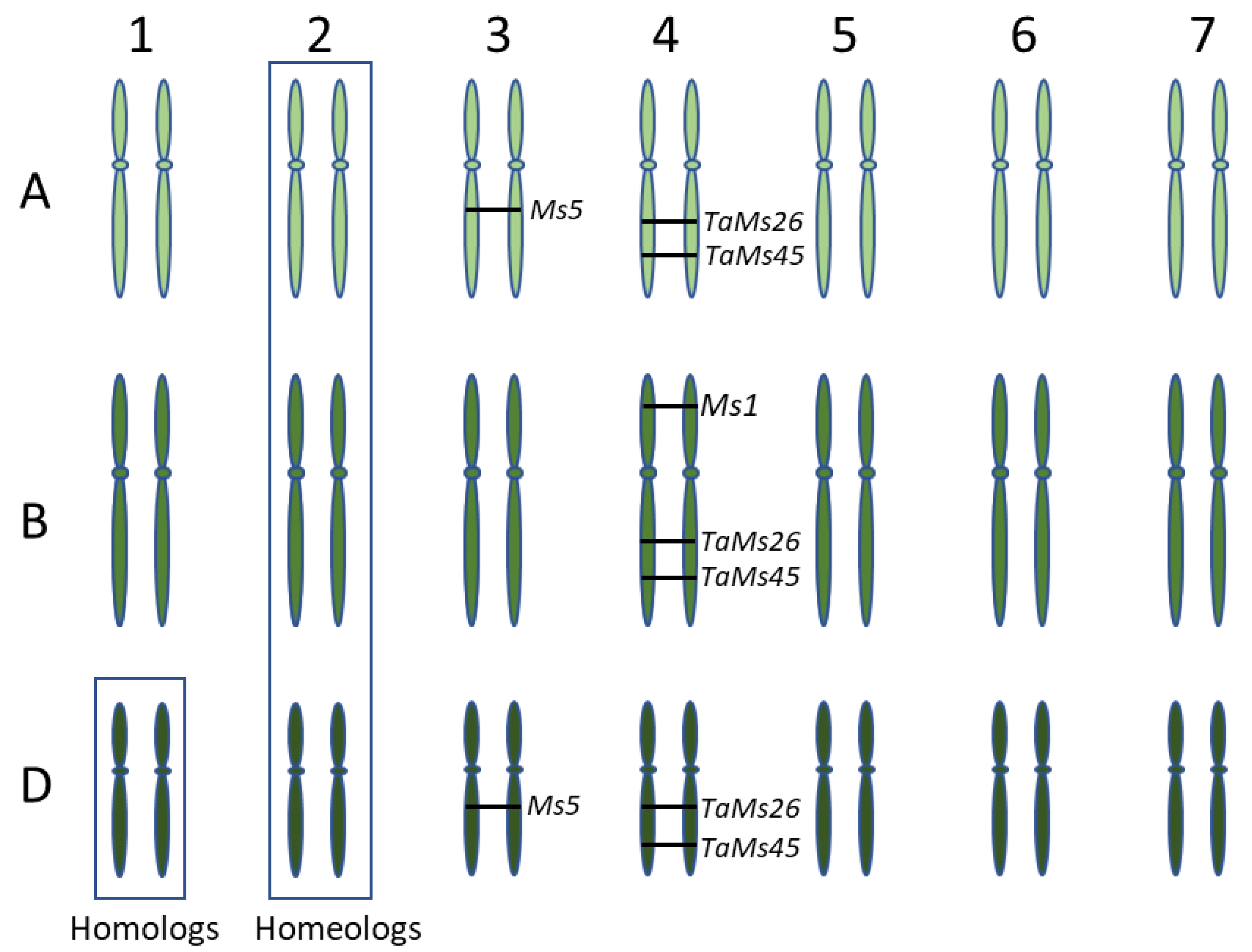
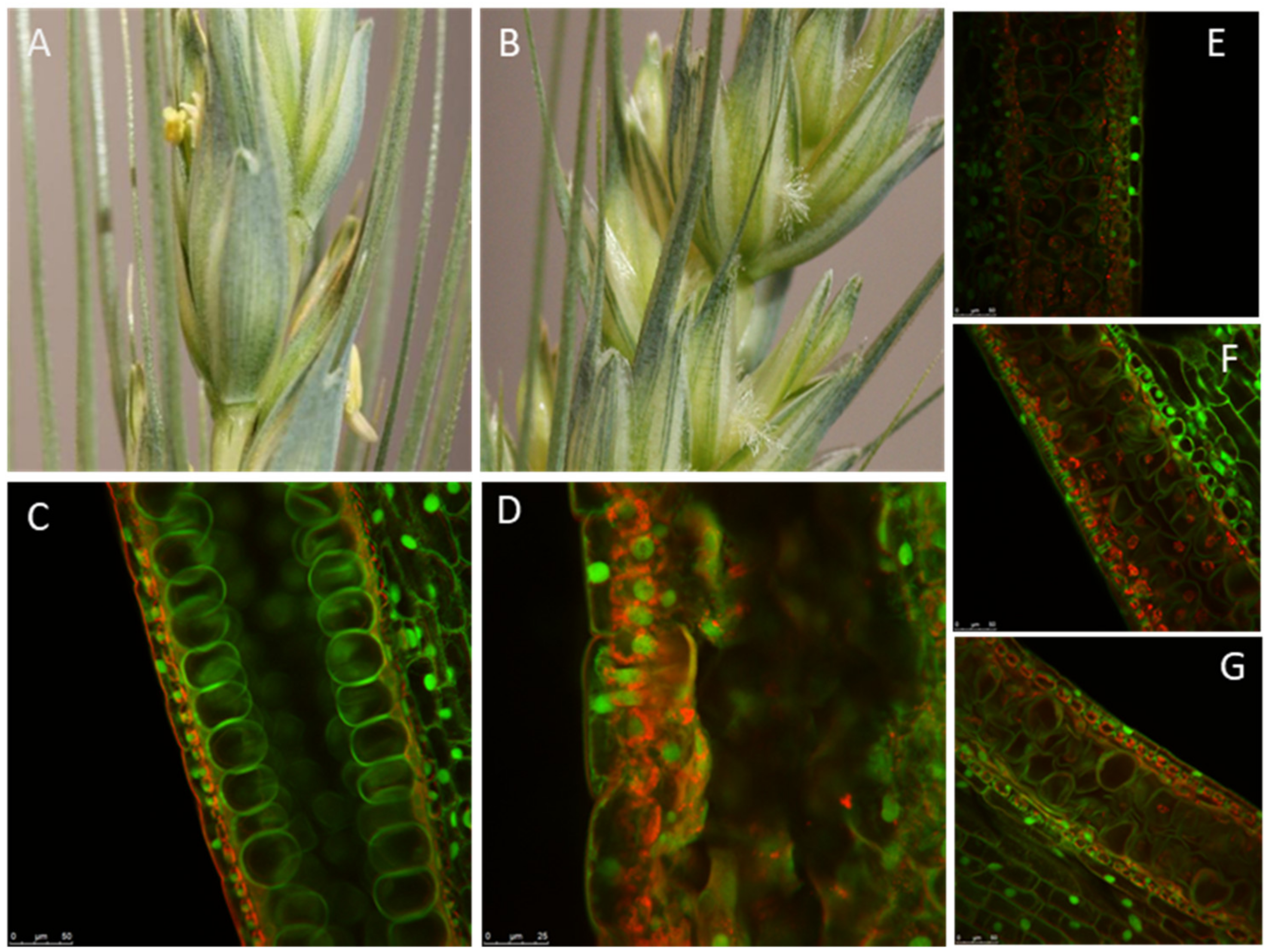
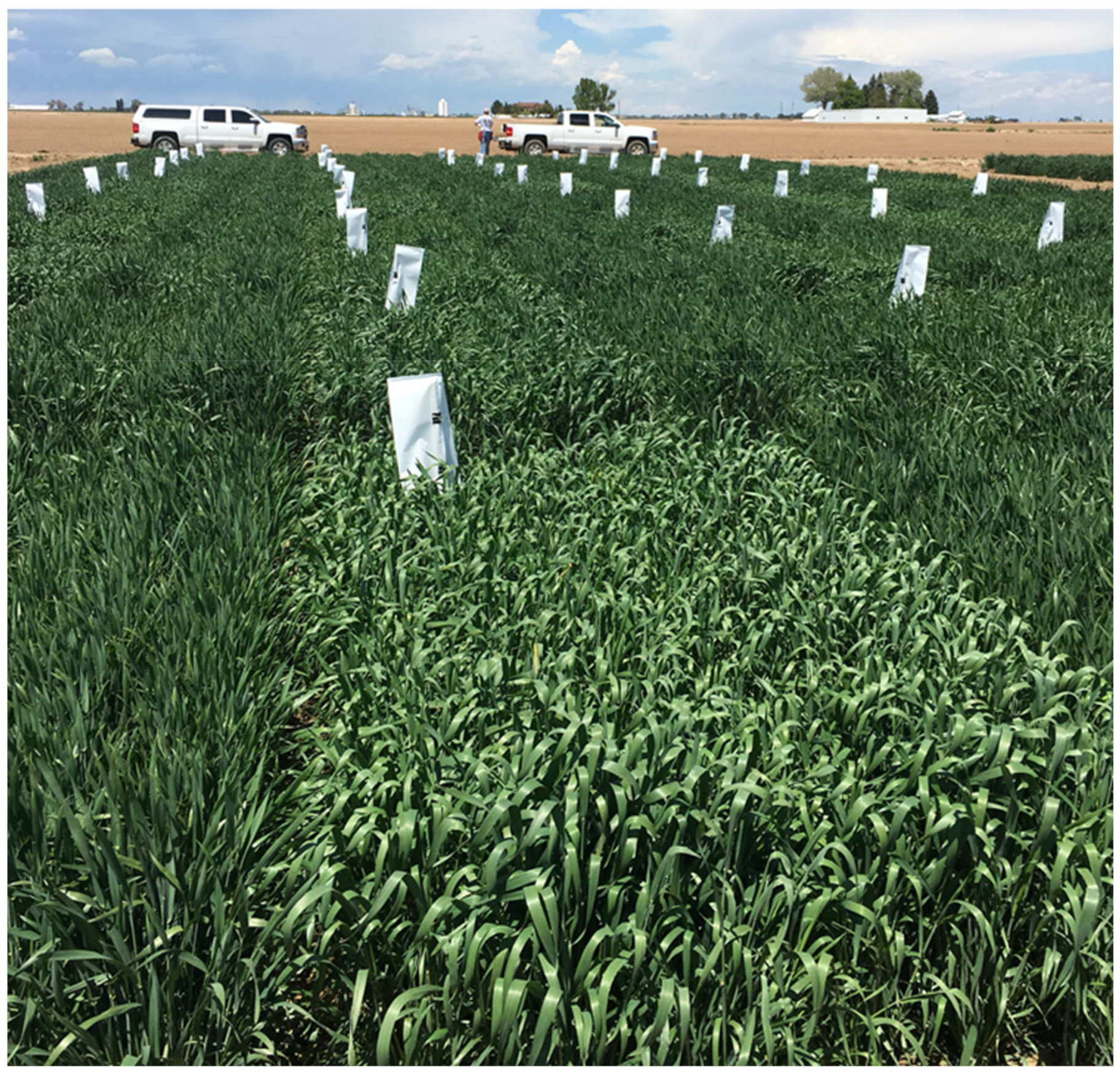
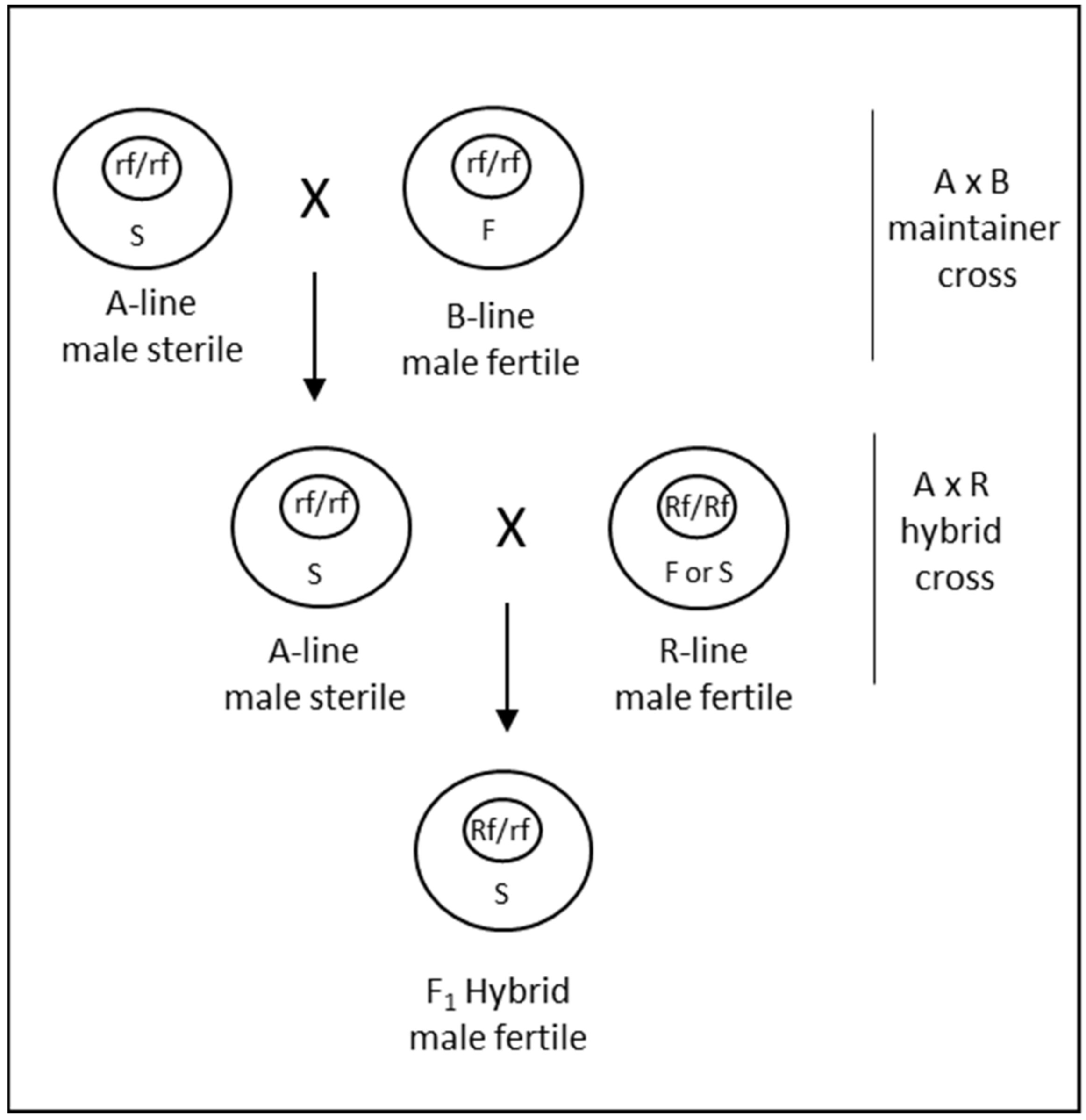
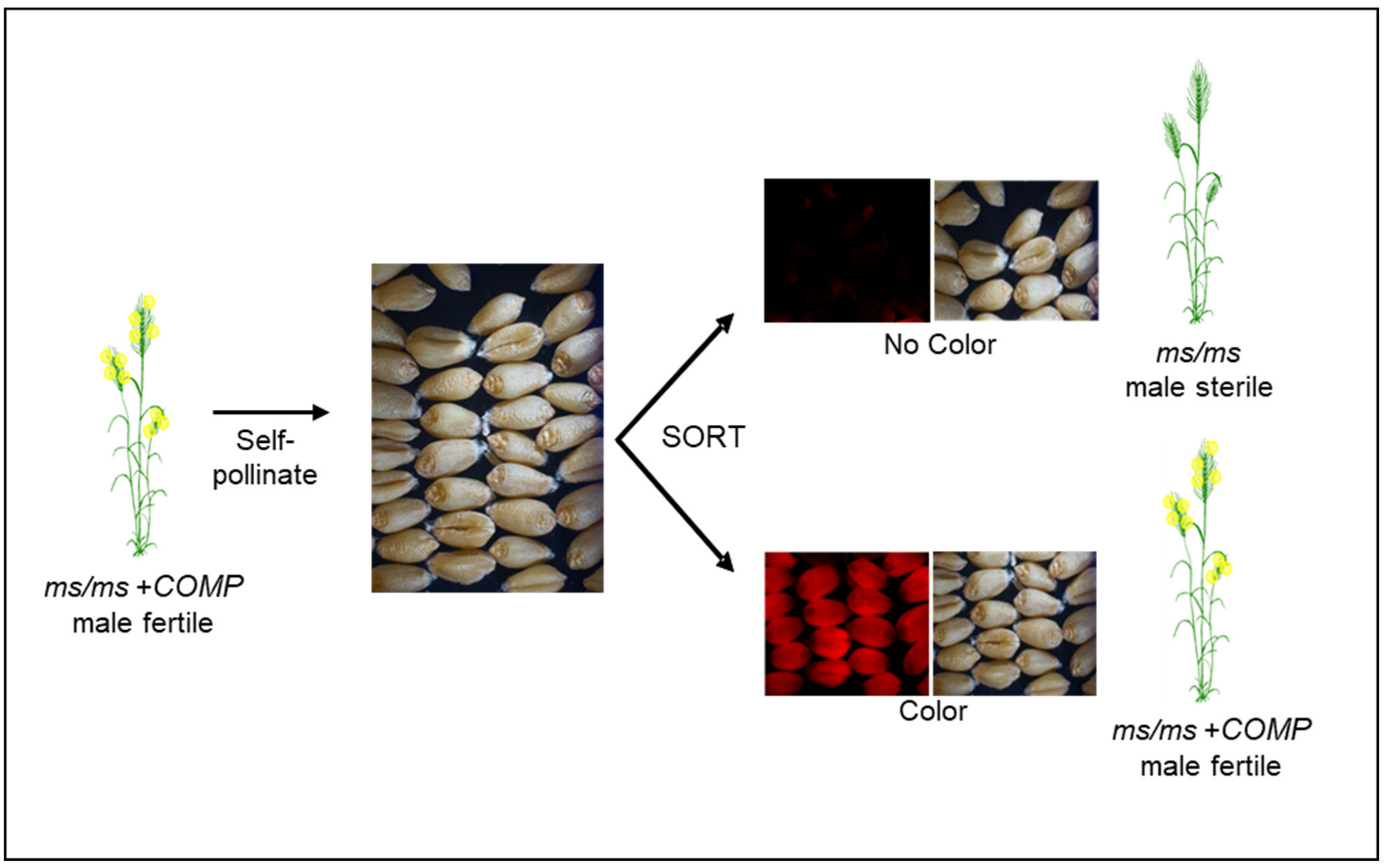
| Mutant | Class | Chromosomes | Functional Homeologs | Reference |
|---|---|---|---|---|
| Pugsley’s (ms1a) | Recessive | 4BS | B | [22] |
| Probus (ms1b) | Recessive | 4BS | B | [23] |
| Cornerstone (ms1c) | Recessive | 4BS | B | [24] |
| ms1d, e, f | Recessive | 4BS | B | [25] |
| Lanhzou (ms1g) | Recessive | 4BS | B | [26] |
| ms1h | Recessive | 4BS | B | [27] |
| Ms2 (Ta1) | Dominant | 4DS | D | [28] |
| Ms3 | Dominant | 5AS | A | [29] |
| Ms4 | Dominant | 4DS | D | [30] |
| ms5 | Recessive | 3A, 3D | A, D | [31] |
| Tams26 | Recessive | 4L | A, B, D | [32] |
| Tams45 | Recessive | 4L | A, B, D | [33] |
| Tanp1 | Recessive | 1L | A, B, D | [34] |
| Tatdf | Recessive | 4L | A, B, D | [35] |
| TacalS5 | Recessive | 7S | A, B, D | [36] |
| Tarpg1 | Recessive | 7L | A, B, D | [36] |
| Taspps | Recessive | A, B, D | [37] | |
| 4110S | TGMS | [38] | ||
| BNY-S (wtms1) | Recessive-TGMS | 2B | B | [39] |
| BNS | TGMS | [40] | ||
| msBS20T | Recessive-TGMS | 2BL | B | [41] |
| 337S | PTGMS | 2B, 5B | B | [42] |
| BS210 | PTGMS | [43] | ||
| BS366 | PTGMS | [44] | ||
| C49-S | PTGMS | [45] | ||
| XN291S | PTGMS | 5B | B | [46] |
| Gene | Chromosomal Location in C.S. | Number of Functional Homeologs | Number of Functional Alleles for Male Fertility | Number of Alleles Required for Complementation | Reference |
|---|---|---|---|---|---|
| MS1 | 4BS | 1 | 1 | 1 | [27] |
| MS5 | 3A, 3D | 2 | 1 | 1 | [31] |
| TaMS26 | 4AS, 4BL, 4DL | 3 | 2 | 2 | [32] |
| TaMS45 | 4AS, 4BL, 4DL | 3 | 1 | 1 | [33] |
| Strategy | Mutant/Gene | Characteristics | References |
|---|---|---|---|
| First-Generation Concepts | |||
| XYZ System | generic | Complementation of a ms mutation with an alien chromosome; three components for female maintenance XYZ; sorting of ms/ms genotype based on vegetative characteristics; 4-line system. | [83] |
| Modified XYZ System | Cornerstone (ms1c) | Wheat or barley isochromosome proposed for complementation of ms1c; maintenance of Y line through self-pollination, eliminating the need for X component; A x B like cross required for propagation of Z line; 3-line system. | [84] |
| Second-Generation Concepts | |||
| 4E-ms | Lanzhou (LZ; ms1g) | Complementation with chromosome 4E from Agropyron elongatum. 4E carries the ms1 homeolog and Blue Aleurone (BA) gene; sorting of ms1/ms1 genotype based on seed phenotype; 2-line system. | [85] |
| SPT-like System based on recessive sterility | ms1, ms5, Tams26, Tams45 | Complementation with a TDNA carrying the wild-type copy of the mutant gene; ms/ms identification based on the seed marker also present in the TDNA; final product is non-transgenic; can be utilized as a 2-line or 3-line system, whichever is efficient. | [27,31,32,33] |
| SPT-like System based on dominant sterility | TaMS45-pIR | Dominant male sterility; proof of concept transgenic but gene editing can provide a more regulatory-friendly system; manipulation of male lines also needed. | [56] |
| DNA (Adenosine-N6-)-Methyltransferase(DAM) | Dominant male sterility; transgenic; manipulation of male lines also needed. | [56] | |
| SPLIT Gene | Barnase (B. amyloliquefaciens) | Based on two components (split) of barnase gene; transgenic; no manipulation of male lines needed; an A x B-like cross needed for maintenance; 3-line system. | [86] |
| Chemical complementation | TaSpPS | Male sterile Taspps mutants can produce seed with application of oxo-6-octadecane-pyran-2-olate; registration of chemical for commercial use not determined; 2-line system. | [37] |
| Third-Generation Concepts | |||
| MS45-BA | Tams45 | Complementation with telosome 4EL from Thinopyrum ponticum; MS1 and BA in tight linkage (same chromosome arm); triple-gene knockouts required for male sterility; 2-line system. | [33,87] |
| Modified 4E-ms | ms1 | Complementation with an engineered alien chromosome; MS1 and BA in tight linkage (same chromosome arm); 2-line system. | [87,88] |
| Updated XYZ | tip2 | Complementation with barley 7H monosomic addition line; seed sorting based on waxy endosperm/seed phenotype; 3-line system. | [14] |
| MFW-PV-OV Maintainer | generic | Requires complex gene editing or transgenic manipulation to combine MFW, PV and OV components in tight linkage; 3-line system. | [89] |
Publisher’s Note: MDPI stays neutral with regard to jurisdictional claims in published maps and institutional affiliations. |
© 2021 by the authors. Licensee MDPI, Basel, Switzerland. This article is an open access article distributed under the terms and conditions of the Creative Commons Attribution (CC BY) license (https://creativecommons.org/licenses/by/4.0/).
Share and Cite
Singh, M.; Albertsen, M.C.; Cigan, A.M. Male Fertility Genes in Bread Wheat (Triticum aestivum L.) and Their Utilization for Hybrid Seed Production. Int. J. Mol. Sci. 2021, 22, 8157. https://doi.org/10.3390/ijms22158157
Singh M, Albertsen MC, Cigan AM. Male Fertility Genes in Bread Wheat (Triticum aestivum L.) and Their Utilization for Hybrid Seed Production. International Journal of Molecular Sciences. 2021; 22(15):8157. https://doi.org/10.3390/ijms22158157
Chicago/Turabian StyleSingh, Manjit, Marc C. Albertsen, and A. Mark Cigan. 2021. "Male Fertility Genes in Bread Wheat (Triticum aestivum L.) and Their Utilization for Hybrid Seed Production" International Journal of Molecular Sciences 22, no. 15: 8157. https://doi.org/10.3390/ijms22158157
APA StyleSingh, M., Albertsen, M. C., & Cigan, A. M. (2021). Male Fertility Genes in Bread Wheat (Triticum aestivum L.) and Their Utilization for Hybrid Seed Production. International Journal of Molecular Sciences, 22(15), 8157. https://doi.org/10.3390/ijms22158157






